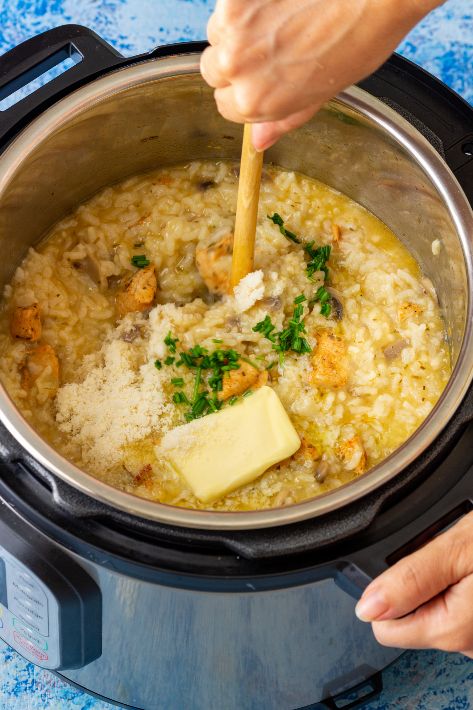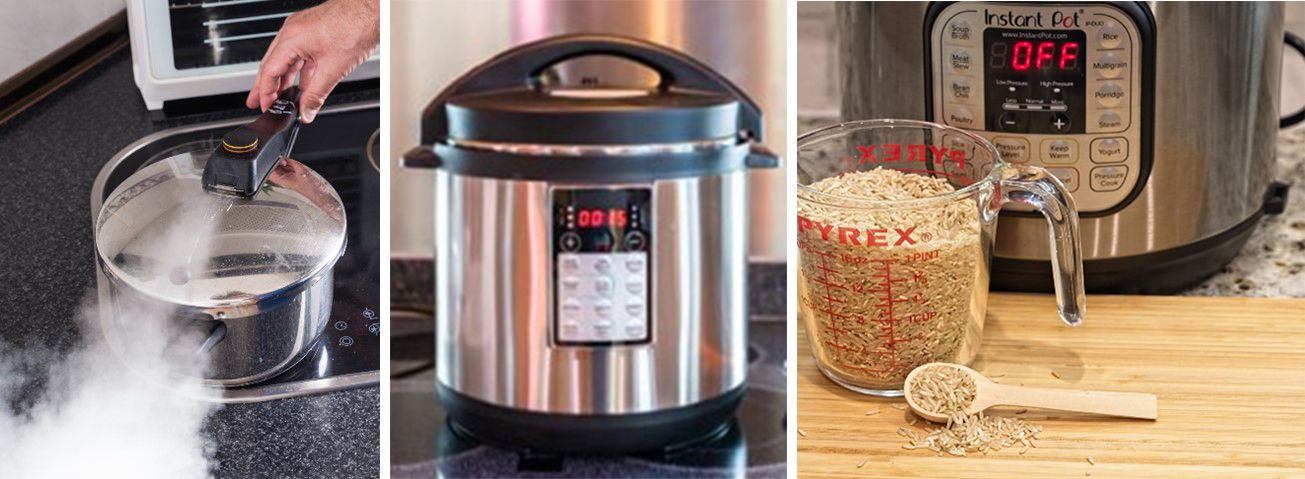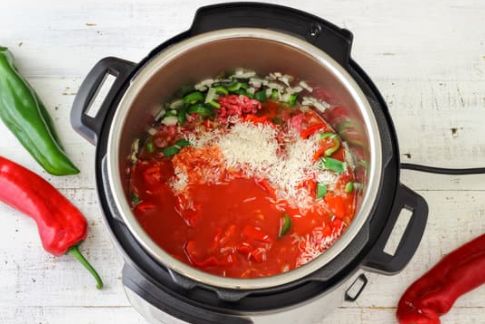
Credit: Canva.com
The Stigma about Pressure Cookers
Pressure cookers became a popular kitchen appliance in the 1950s and were commonly used to can homegrown produce. Unfortunately, early models of pressure cookers got a reputation for being “dangerous” due to their poorly constructed weighted valve that would easily get clogged while cooking. As the pressure built up in the cooker, gaskets would then blow, causing water or steam to spew out or the lid to fly off. Fortunately, modern pressure cookers now come with several fail-safe mechanisms to ensure safety, such as multiple valves, dual pressure regulators, and spring-loaded locks. Now pressure cookers are making a comeback and are helping families cook amazing meals in a fraction of the time.
How does a pressure cooker work?
A pressure cooker is a tightly sealed pot that uses high pressure to cook food fast. As the pot heats up, the liquid inside becomes steam, which increases the pressure in the pot. Because the steam’s temperature can reach around 250°F (which exceeds the temperature of boiling water at 212°F), food is able to cook faster. The high pressure also forces liquid and moisture into the food being cooked, which not only makes it cook faster, but helps tough meat get very tender and become more flavorful as well.

Credit: Canva.com
The Differences between a Stovetop Pressure Cooker, an Electric Pressure Cooker, and an Instant Pot®
Stovetop pressure cookers can reach higher temperatures and pressure than electric pressure cookers, so they are able to cook food faster. Electric pressure cookers cook food a little slower than their counterparts; however, they come with more functions and features, and you don’t have to watch them as carefully as stovetop pressure cookers. Instant Pot® is a brand of electric pressure cookers. Many models have more advanced features, including Alexa integration and WiFi connectivity, which give more control while cooking.
What can you cook in a pressure cooker?
Pressure cookers are versatile and are designed to cook things quickly. Pressure cookers are helpful for cooking roasts and other tough cuts of meat that need to be tenderized. They can cook rice and pasta in as little as 5 minutes and dried beans in about 30 minutes. Soups and stews cook in under an hour yet taste like they have simmered all day. There are many recipes and cookbooks online on how to cook everything from hard-boiled eggs to short ribs, and crème brûlée to cinnamon roll steel-cut oats. You can find these recipes and more, here: “56 Easy Pressure Cooker Recipes” (https://www.brit.co/beginner-pressure-cooker-recipes/) and “100 Pressure Cooker Recipes” (https://www.tasteofhome.com/collection/pressure-cooker-recipes).
What are the benefits of a pressure cooker?
Pressure cooking reduces most cooking times by about 70%. However, while actual cooking time is decreased, the time it takes for a pressure cooker to reach pressure and release pressure needs to be considered when calculating total preparation time. Because pressure cooking requires less water, and the water is typically not drained off, food keeps its natural flavors and retains most of its nutrients, which makes it healthier to eat. Cooking with a pressure cooker is more energy efficient than cooking with multiple pots on separate stovetop burners, and they won’t heat up your entire kitchen the same way your oven would.

Credit: Canva.com
Pressure Cooker Safety
Always read the manual before use. Check all components before cooking to make sure the silicone gasket is intact and that the locking cover seals securely. Do not overfill the pressure cooker, and be sure to add the required minimum amount of liquid per the appliance’s manual. Do not block the venting valve while cooking or releasing pressure. Using the proper pressure release method will keep the valve from clogging. Do not force the lid open. Tilt the lid away from you when opening to prevent getting burned by steam. Always use proper protective gear when handling the hot components of the pressure cooker.
Food Safety and Pressure Cookers
Frozen food can be cooked in a pressure cooker. Check the appliance’s manual for guidelines, but cooking frozen food usually requires adding more liquid and increasing the cooking time. Use a food thermometer to measure the internal temperature of meat, poultry, eggs, fish and shellfish cooked in a pressure cooker to verify the food has reached the required safe internal temperature as recommended by the USDA: https://www.fsis.usda.gov/food-safety/safe-food-handling-and-preparation/food-safety-basics/safe-temperature-chart.
Cleaning an Electric Pressure Cooker
Do not place the base and the heating element in water or in the dishwasher. Instead, these should be wiped down with a damp cloth. The inner pot and the lid of most models are dishwasher safe (check your owner’s manual for specific cleaning recommendations). The sealing ring should be hand-washed in soapy water, dried completely, and then inspected for cracks or other damage before putting it back in the lid. There is a guard or anti-block shield underneath the lid that prevents the pressure release valve from getting clogged. This part can be washed in warm, soapy water and then wiped dry. Check the steam release valve and the float valve to make sure nothing has clogged the pathways. If the unit has a condensation collector, hand-wash and dry thoroughly before returning it. This needs to be checked regularly for moisture to prevent mold growth.
References
Chin, Tim. 2020. “How Pressure Cookers Actually Work.” Serious Eats. https://www.seriouseats.com/how-pressure-cookers-work
Durand, Faith. 2021. “What Is Pressure Cooking and How Does It Work?” Kitchn. https://www.thekitchn.com/a-primer-on-pressure-cooking-193715
Hutchings, B., J. Buck, S. Greenway, L. Hansen, and A. Robertson. 2021. Guide to Using and Caring for Your Electric Programmable Pressure Cooker. PNW747. University of Idaho Extension. https://www.extension.uidaho.edu/publishing/html/PNW747-Electric-Programmable-Pressure-Cooker
John. 2021. “Differences Between an Electric Pressure Cooker and a Stove Top Pressure Cooker?” Geek Robocook. https://geekrobocook.com/electric-pressure-cooker-vs-stove-top-pressure-cooker/#:~:text=Stovetop%20pressure%20cookers%20take%20their,a%20number%20of%20different%20functions
Memken, Jean A. 2018. Electric Pressure Cookers: What Consumers Need to Know. FRM-SCS.009. University of Kentucky Cooperative Extension. https://grayson.ca.uky.edu/files/electric_pressure_cookers.pdf
Seaman, Greg. 2012. “Top 6 Benefits of Pressure Cooking.” Eartheasy. https://learn.eartheasy.com/articles/top-6-benefits-of-pressure-cooking/